From "quanta" to molecules: Exploring the infinite possibilities of computing | Roundups
At the end of 2023, two landmark research papers have generated widespread attention in the journal Science. These two papers, from two separate research groups, together revealed the results of research on the interactions between single calcium fluoride molecules, successfully creating molecular quantum bits between these molecules. This achievement not only marks the establishment of molecules as a strong contender in the field of quantum simulation, but also an important contribution to the scientific exploration of quantum information.
In the face of the already challenging fields of quantum biology and cognitive science, the role of molecules is becoming more and more indispensable. Against this backdrop, a new review article has emerged focusing on molecular quantum computing - an emerging research direction that is pushing the boundaries of research in related fields. The review, published Feb. 21 in Intelligent Computing, aims to provide insights into the potential of molecular quantum computing and its possible implications in theory and practice.

The quantum nature of electrons, cores, and spins inside molecules provides new research directions and possibilities for quantum information science. The authors point out that the study of molecular quantum computing may not only broaden the boundaries of quantum computing, but also help us to gain a deeper understanding of human cognitive processes. By exploring molecular quantum computing, a new field of research linking cognitive science and quantum biology, major theoretical breakthroughs may occur in the future.
In this media article, the ICV team has carefully translated and interpreted the relevant innovative research papers with the aim of disseminating cutting-edge knowledge in this field. Meanwhile, we also encourage interested readers to read the original papers in depth for richer insights.
The Evolutionary Journey of Computing Technology
Computing, as a goal-oriented information processing activity, has undergone several important evolutions since the beginning of human civilization. Throughout history, humans have revolutionized the ways, tools, and representations of computational elements.
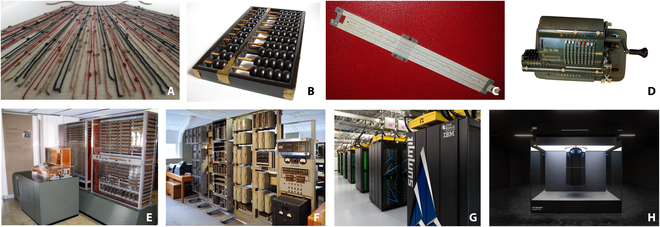
Upon entering the digital age, high and low voltages represented the numbers 1 and 0, respectively, in the binary system, a revolutionary development that drove rapid advances in silicon chip-based electronic computer technology. Today, quantum computing, which utilizes the ability of quantum bits (qubits) to exist in multiple states (superposition of states) at the same time, is seen as the new frontier in computing.
Originally proposed by physicists R. P. Poplavskiĭ and R. P. Feynman, quantum computing aims to simulate quantum systems or perform tasks that pose a challenge to conventional computers through the principles of quantum physics. The superposition state of quantum bits confers a natural advantage in solving complex computational tasks, such as large integer prime factorization and Schorr's algorithm. In the field of general-purpose quantum computing, building quantum computers with a large number of quantum bits faces many challenges. To realize practical quantum computing tasks, millions of quantum bits are required to encode hundreds of logical quantum bits using existing noise control techniques. In analog quantum computing, on the other hand, it is relatively easier to implement large-scale quantum bits.
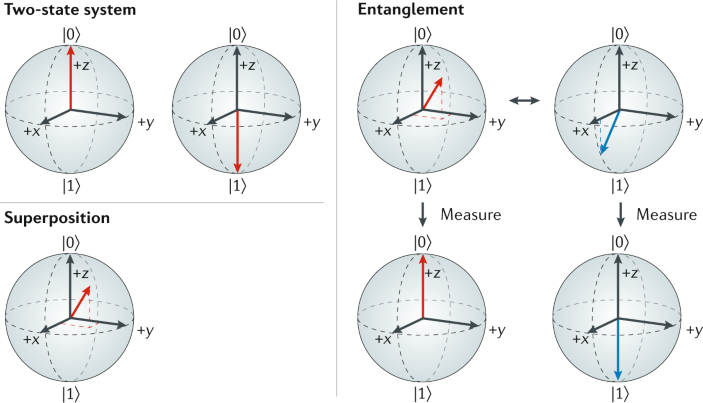
As an example, IBM's 1,000+ quantum bit machine announced in 2023 is set to reach 100,000+ quantum bits. Nonetheless, this is still a far cry from the 10^6 quantum bits needed to realize a practical quantum computer with proper error correction capabilities. However, with further technological breakthroughs, it will become possible to have a powerful quantum computer capable of performing practical computational tasks, especially in areas such as accurate weather forecasting or modeling chaotic phenomena. For example, topological quantum computing is expected to dramatically reduce the number of quantum bits required.
To date, several types of quantum bits and their corresponding quantum gate operation mechanisms have emerged. Initial quantum computer designs were based on unpaired electron spins in silicon dopants, and the interactions between these spins were controlled via external electrodes. In addition, schemes combining nuclear spins in liquid environments with NMR techniques have been proposed. Other promising candidates for quantum bits include dopants in semiconductors other than silicon, nitrogen vacancy centers in diamond, silicon quantum dots, and cold atomic and molecular electron spins.
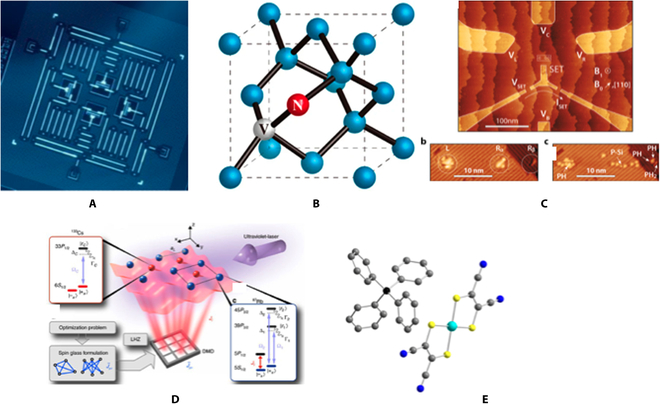
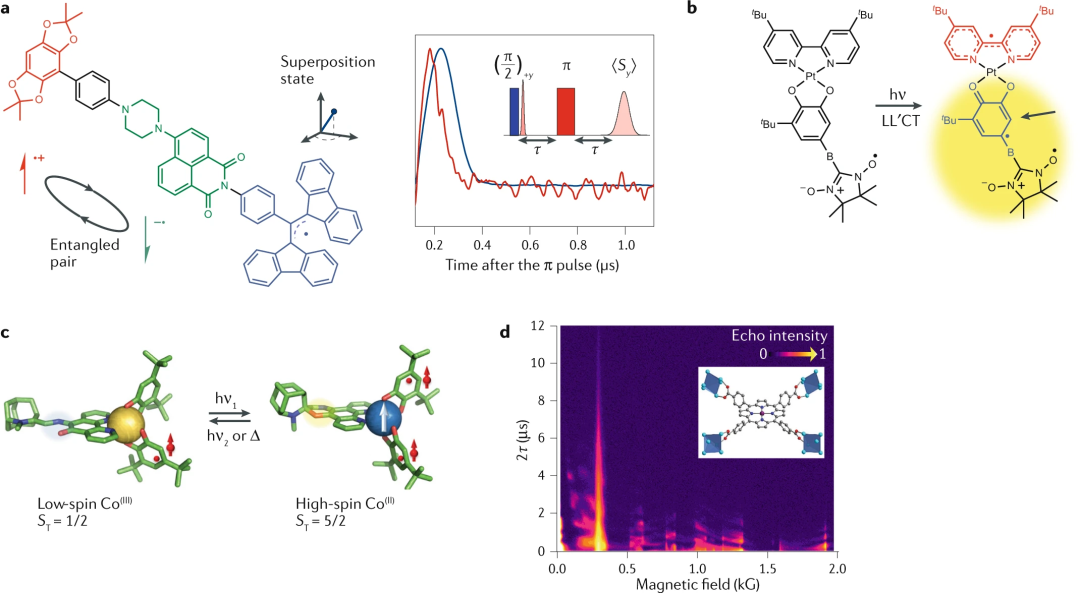
Candidate molecular quantum bits
Molecular Quantum Computing to Unravel "Unsolved Mysteries"
Over the past half century, molecular science and technology have undergone radical changes, especially in the fields of molecular electronics, organic spintronics and molecular magnetism, where significant progress has been made. Among them, the rapid development and commercialization of organic light-emitting diode (OLED) technology has led to its wide application in display technology and smartphone screens. Meanwhile, organic solar cells, as an important part of new energy technologies, have shown great potential in reducing carbon emissions.
In addition to their wide range of applications in optics, magnetism and spintronics, organic molecules have also become a hot new field of quantum technology research due to their portability, tunability and scalability. Although research in molecular magnetism, spintronics and quantum technology is still in the exploratory stage, they have great potential for application in basic science and future technology. Researchers from multiple disciplines, such as physics, chemistry and materials science, have shown great interest in molecular quantum technologies such as quantum sensing, quantum communication and quantum computing.
Thanks to continuous advances in chemical synthesis and molecular engineering, molecular quantum computing shows advantages in numerous aspects, including higher operating temperatures and a virtually unlimited number of candidate molecules. The fact that molecules contain mostly lighter-mass elements of carbon, nitrogen, oxygen, and hydrogen allows molecular quantum computing to work at higher temperatures. Over the past few decades, "click chemistry" has developed into a powerful tool for synthesizing molecules for biomedical purposes that can be further used to construct molecular quantum bits and networks.
Quantum biology, on the other hand, applies the principles of quantum mechanics to explain biological phenomena that cannot be properly explained by classical physics. In the field of quantum biology, research in the areas of photosynthesis, free radical-magnetic field interactions, olfaction, vision, long-range electron transfer, and enzyme catalysis are highly attractive. Together, quantum biology and molecular quantum computing explore quantum effects and reveal their profound impact on life processes.
Cognitive science explores how the biological nervous system collects, processes, abstracts and transmits information, aiming to reveal the principles behind intelligence and its learning processes. Inside neurons, microtubules, mitochondria and axons are key components for information transmission. Microtubules act as centers of consciousness and are responsible for the continuous transmission of electrical charge; mitochondria provide energy drive; and axons are responsible for the transmission of electrical signals and may transmit biophotons in a specific spectral range produced by biological systems.
Hameroff and Penrose's Orch objective reduction theory introduced the concept of quantum processes within neuronal microtubules, introducing quantum dynamics to brain science. Penrose proposed objective reduction of isolated quantum states to classical states, independent of environmental decoherence, driven by the underlying spacetime geometry. This theory, in which "non-computability" (non-computability) is considered a key feature of consciousness, pushes the boundaries between determinism and randomness.
Currently, research efforts are working to establish links between quantum biology and cognitive science, exploring how quantum effects can deepen our understanding of biological systems and cognitive processes. The information processing mechanisms of the human brain and their relevance to human intelligence and learning have become a central topic in connecting quantum computing and cognitive science. In this field, the working mechanism of neurons (whether it relies on the classical physical level or the quantum level) remains an open question. Molecule-based quantum computing is not only expected to unravel these mysteries, but also to provide new perspectives on our understanding of human intelligence.
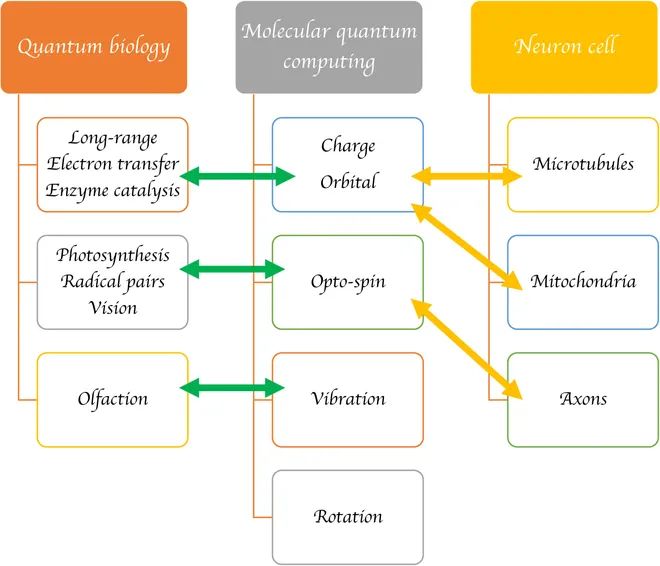
Link between quantum biology, molecular quantum computing and key components in neurons
Quantum physics has ushered in a new era of science, with core concepts including the wave function, superposition states and the Schrödinger equation. The wave function provides a mathematical framework to characterize the motion of microscopic particles, which not only carries information about the probability of discovery of a particle, but also contains phase factors that are key to understanding topological properties. The principle of superposition, borrowed from classical wave dynamics, is one of the core principles of quantum computation, which allows a system to exist in the "sum" of multiple states at the same time, providing a theoretical basis for realizing parallel processing of quantum bits, which significantly improves computational efficiency.
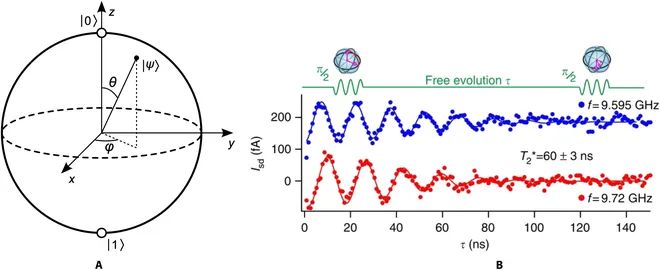
Effective decoherence control strategies are essential to maintain quantum coherence and enable efficient quantum computation. For example, the interaction of molecular spins with vibrational modes leads to the decay of spin states, a decoherence process that can be viewed as a deformation of the Bloch sphere. Recent studies have revealed that the decoherence time of neurons is as long as 10 μs, similar to that of molecular spin quantum bits and copper phthalocyanine and vanadium phthalocyanine molecules (CuPc, VOPc), which also contain aromatic rings that are key organic components of photosynthesis. Decoherence may also facilitate the creation of entanglement, providing new perspectives for quantum computation in high-noise environments such as the human brain.
The concept of degrees of freedom plays an important role in explaining the phenomenon of consciousness in quantum biology and cognitive science. The complex structures within neurons and even individual proteins can accommodate numerous degrees of freedom. In these complex molecular structures, shifts or jumps in charge can represent quantum bits, similar to the coupling of two-qubit systems in quantum computing. Recent studies have shown that long-range electron transfer and hydride tunneling in enzyme catalysis display strong quantum properties that are closely related to charge and orbital degrees of freedom. These degrees of freedom are also applicable to molecular quantum computing, where electron-flying quantum bits can transfer information between quantum computing circuits, and where charge transfer is a physical process integral to microtubule and mitochondrial function.
Axons in neurons may be key elements of molecular quantum computing through biophotons and spin. Although vibrational degrees of freedom have been recognized as critical for olfactory perception, they have not been extensively explored in neuronal studies. Furthermore, the importance of spin degrees of freedom and free radicals for neuronal performance has been demonstrated, and molecular spins bound to light are considered by many research teams to be ideal for quantum computing. Vibrational and rotational modes are crucial for molecular spectroscopy and have a wide range of applications in biology, physics and astronomy. However, to the authors' knowledge, these two degrees of freedom have not been extensively studied in quantum computing or cognitive science.

Molecular-based quantum computing not only promises to increase the number of quantum bits and improve the operating temperature of quantum computers, but also faces a unique opportunity to mimic the working mechanism of neuronal cells. Quantum computing based on DNA nanostructures is now being proposed as a promising strategy, giving new impetus to this exciting research direction.
The exploration of these degrees of freedom opens up new pathways for molecular quantum computation. The study of charge degrees of freedom, such as coherent electron hopping in neurons, is relatively easy to realize because of the existence of a large number of candidate molecules that can serve as donors, acceptors, and free radicals. Given the extensive molecular studies that have been performed, it is feasible to use simple molecular structures to elucidate charge-based quantum computation. Recent studies of coherent charge transfer processes in organic solar cells and light-emitting diodes have provided useful insights into molecular quantum computing.
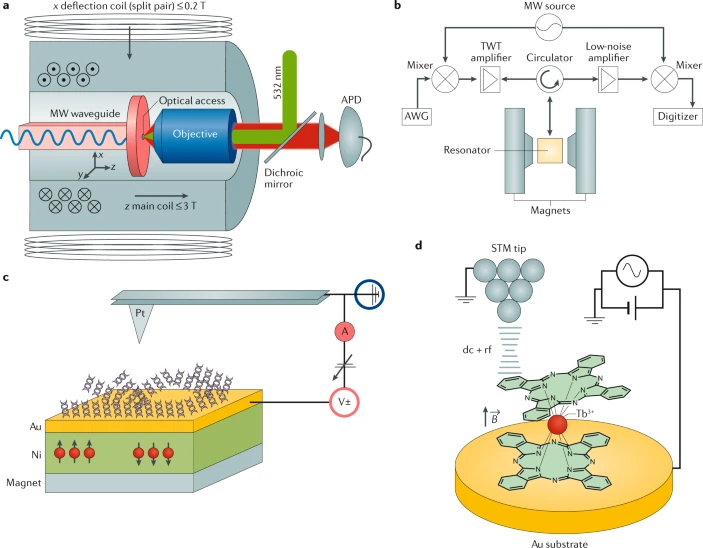
Extend, manipulate, and measure molecular architectures
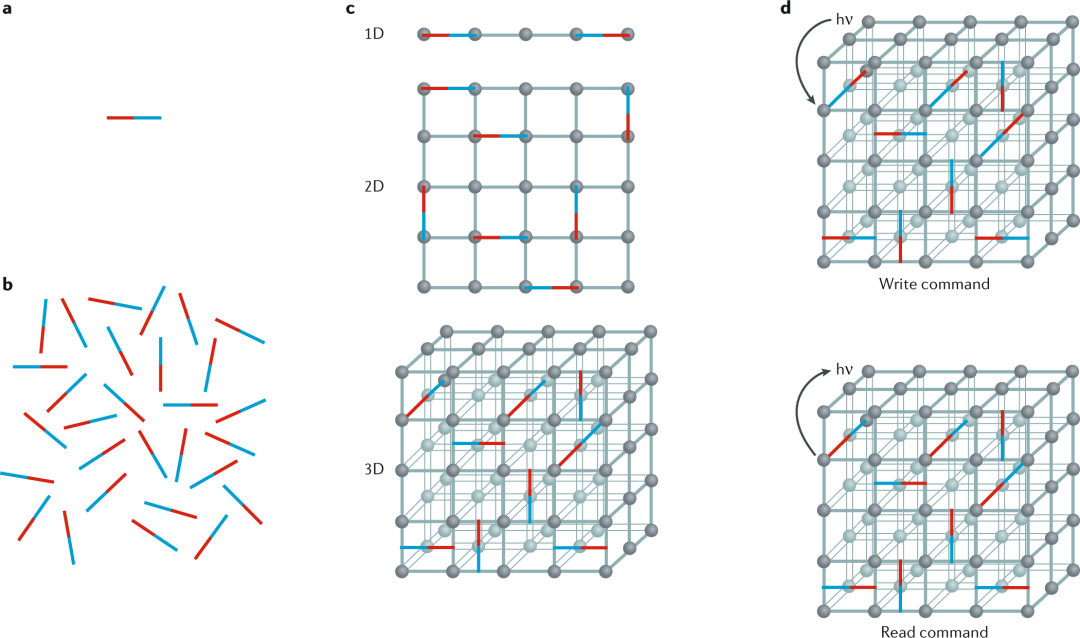
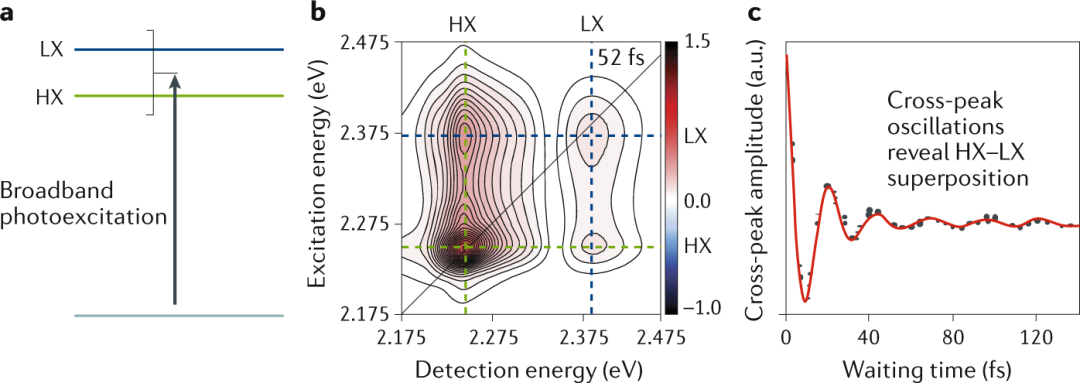
Ultrafast spectroscopy using ultrashort pulse sequences allows the preparation of coherent superpositions of electronic and vibrational states
Ultrafast spectroscopy, which prepares coherent superpositions of electronic and vibrational states and analyzes the ensuing dynamics through the use of extremely short pulse sequences (~10 fs), has emerged as a groundbreaking method for studying complex molecular systems. However, data from ultrafast laser experiments can be affected by ensemble fading, an effect that may mask the coherence inherent in the system within the ensemble, which is the reason for recent efforts to achieve single-molecule precision. Although the intensity of the nonlinear optical signals is low, achieving this goal appears to be within reach using fluorescence detection methods and single-molecule pump-probe experiments.
Although coherent spectroscopy has proven to be very effective, the broader toolbox of quantum measurements is not yet widely available in chemistry. New spectroscopic techniques can utilize measurement principles such as non-demolition, weak or projective measurements to collapse the wave function. In addition, by exploiting the non-classical correlations of light sources, quantum metrology can improve detection sensitivity, leading to the design of more accurate analytical chemistry solutions. Many such technological developments are expected to occur in the coming years.
The wide range of possibilities for electronic states, electron spins, and nuclear spins calls for innovative and integrated experimental techniques that combine the use of quantum optics and fully coherent pulsed magnetic resonance spectroscopy (EPR and NMR) to probe and manipulate these degrees of freedom. Recent advances in spin manipulation techniques provide opportunities for precise manipulation of electron and nuclear spins and pave the way for novel quantum information systems for preparation, manipulation, transport and readout strategies
The study of molecular quantum bits has opened a new era of quantum computing, and their fabrication, characterization, and functionality are facing a variety of challenges triggered by the coupling of electronic degrees of freedom, including the management of coherent and decoherent effects, excited state control, tunability, and a deeper understanding of entanglement processes in optically prepared states. The solution of these complex problems does not depend only on a single approach, but requires a seamless integration of quantum mechanics and classical mechanics in order to comprehensively deal with systems and processes spanning multiple length and time scales and to accurately model fundamental interactions.
Translated with DeepL.com (free version)
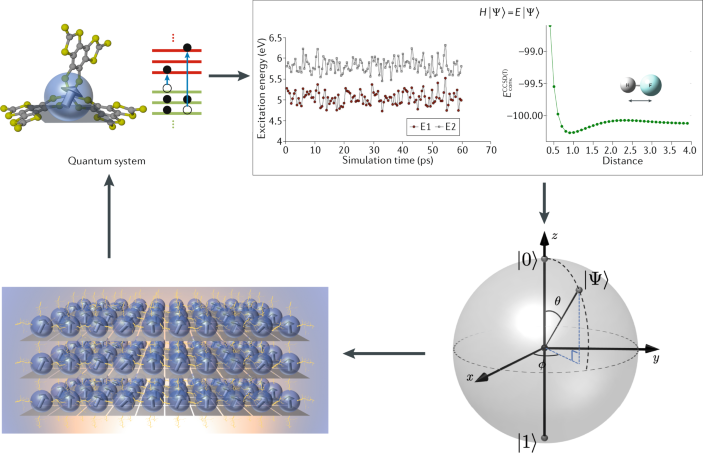
In order to fully characterize the interactions of molecular systems with external fields and excited states, we need to interconnect various forms of characterization of many-body phenomena encompassing wavefunctions, density matrices, electron densities, and self-energy parametrization with the help of state-of-the-art electronic structure methods and strategies.
Describing the spin properties of electronic states that are candidates for molecular quantum bits needs to incorporate a variety of interactions such as external field coupling, hyperfine interactions, spin-orbit coupling, magnetic spin exchange, and other relativistic effects. Accurate treatment of these interactions can help develop accurate models based on them, and further reveal how to control quantum states and manage decoherence time scales with the help of these interactions.
The latest experimental techniques allow us to probe matter on unprecedented length and time scales. For example, ultrafast, attosecond multidimensional X-ray spectroscopy has been able to reveal the electronic structure and dynamical behavior of molecules in response to short pulse sequences. In addition, these techniques are capable of tracking electronic coherence in atomic and diatomic molecules in real time. Although decoherence in real complex systems has been extensively studied by empirical and low-order methods, the deeper connection between electronic correlations and decoherence has not been fully explored. In order to understand how electron correlation affects the coupling between electrons and nuclear subsystems, we need to perform molecular dynamics simulations using high-precision electronic structure methods that take into account electron-nucleus coupling.
Extending these methods to more complex molecular and material structures will rely on theoretical advances in electronic structure methods, spectroscopy, nonlinear optics, and complex nonadiabatic molecular dynamics, while spin-orbit effects and environmental effects need to be considered.
Addressing the chemical complexity and time scales encountered in the design and characterization of molecular quantum bits will increasingly rely on the explanatory power and evaluation capabilities of molecular dynamics simulations. Simulating processes from the atomic to the macroscopic scale requires coping with the unusual bonding behavior of materials, complex and variable operating environments, as well as the extremely high demand for parameterization and reliability in the simulation process. Despite the increasing accuracy and efficiency of computational methods, the value of these tools for simulating multi-qubit arrays will be limited without improved techniques for traversing high-dimensional phase spaces and sampling.
For example, sampling timescales for chemical reactions and molecular simulations can vary by up to 12 orders of magnitude. Current methods for exploring phase space remain imperfect, e.g., explicit time integrators for nonlinear differential equations are difficult to parallelize and require small time steps. In addition, search techniques for complex processes rely on appropriate order parameters, which are often unknown. We are in dire need of new time integration methods, effective phase space exploration techniques, proper order parameter selection methods, and the incorporation of elements of machine learning techniques to build faster electronic structure methods and more robust approximate molecular dynamics models.
Overall, this article synthesizes recent advances in quantum biology, molecular quantum computing, and the study of neuronal quantum effects.
These analyses reveal that molecular quantum computing not only promises to be an important connection between quantum biology and cognitive science, but also plays a crucial role in resolving the quantum mechanisms of neurons, a key element of cognitive science.
It is widely expected in the scientific community that the synergies between quantum information science and chemistry will explode in the coming years. Molecules provide a versatile platform for building complex arrays of multiple quantum bits, which will have far-reaching implications for quantum computing, communication, and quantum sensing in complex condensed matter and biological environments. Such molecular systems are both a bridge between atomic-level and solid-state quantum information architectures and a powerful tool for providing solutions to key societal challenges such as renewable energy and healthcare.
In particular, a deeper understanding of quantum coherence in molecular systems could not only have a groundbreaking impact in areas such as energy production and storage, but also guide the synthesis of new molecules and materials to drive the energy transition toward efficiency and environmental friendliness. The powerful synthetic capabilities of chemistry allow us to customize molecular systems to meet the needs of specific applications. At the same time, the development of new spectroscopic methods allows scientists to resolve quantum coherence in complex molecular systems and apply this knowledge to quantum information integrated systems, opening up new avenues for quantum information processing and reading.
The development of new theoretical models will greatly contribute to the understanding of this emerging field and will not only accurately characterize quantum phenomena within molecular systems, but will also be an important tool for predicting and designing new molecular systems for future applications in quantum information science.
Thus, molecular quantum computing is not only a link between quantum biology and cognitive science, but its impact will extend far beyond these two fields.






